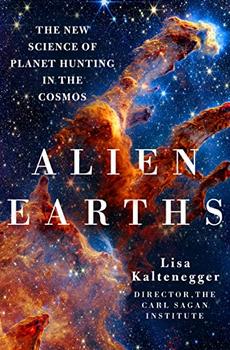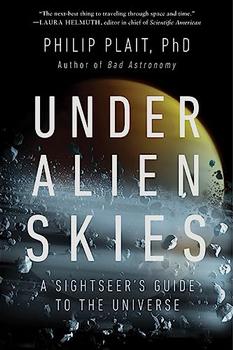Summary | Excerpt | Reviews | Beyond the book | Read-Alikes | Genres & Themes | Author Bio

The New Science of Planet Hunting in the Cosmos
by Lisa Kaltenegger"We are living in an incredible time of exploration," says Alien Earths author Dr. Lisa Kaltenegger, and after reading her new book it's impossible to argue. Only in recent years have we developed the technology and skills to search other galaxies for exoplanets similar to Earth and examine them for signs of life. After all, the full title is Alien Earths: The New Science of Planet Hunting in the Cosmos, and planet scout Dr. Kaltenegger gives us exactly what we came for.
She offers insight into why our planet holds complex life to begin with, explaining a crucial elemental fusion. Earth exists within a galactic sweet spot, coined the Goldilocks zone by scientists — the perfect location in relation to the sun: not too hot (like Venus), not too cold (like Mars), and most importantly, able to hold liquid water. This is because "[L]ife on Earth is built on carbon scaffolding, and it uses water as its solvent (a powerful medium that dissolves substances). The abundance of hydrogen, carbon, and oxygen in the universe means that life on other worlds, if it exists, is likely to be supported by water and carbon."
Dr. Kaltenegger herself is responsible for many advancements in the field. Early in her double career of astronomy and engineering, she was invited to Yellowstone National Park for a field study. There, she observed the array of colors indicating microorganisms within the famous geysers. She explains, "I realized that astronomers needed a color catalog of life — a database of diverse Earth biota and information on how they reflected incoming starlight — to compare to what our telescope would find on exoplanets." This experience led her to found the Carl Sagan Institute at Cornell, gathering a team of scientists from fields far beyond astronomy to assist her in the hunt for cosmic life. Dr. Kaltenegger's excitement is tangible on every page of Alien Earths, as she guides readers through the universe and onto newly discovered star systems and exoplanets. (To learn about another exoplanet specialist, see our article on Sara Seager.)
The search was kicked off with the monumental Kepler mission in 2009. Harnessing a one-and-a-half-meter-long mirror, the telescope found habitable worlds by searching more than 150,000 stars at the same time. Kepler62 is one of the stars found, and it has two exoplanets, Kepler 62 e and Kepler 62 f, within the Goldilocks zone. Another star found is TRAPPIST1, which has seven Earth-sized planets, with three of them orbiting within the habitable zone: TRAPPIST 1 e, f, and g (although g is maybe a bit too cold for life). While an exoplanet orbiting within a Goldilocks zone shows it holds the capacity for life as we know it, scientists haven't discovered any just yet. There's also the chance that life could have evolved entirely differently somewhere else, in a way that is foreign to what we're used to — devoid of water and carbon, perhaps. Scientists continue to study these optimistic possibilities.
Though the Kepler mission could search far across the universe, scientists needed a different telescope that could search our closest star neighbors for exoplanets. Enter Dr. Kaltenegger's Transiting Exoplanet Survey Satellite (TESS) program. Once it was launched, using its "four seventeen-centimeter cameras, it searched the whole sky for tiny blips, tiny changes in the brightness of our closest stars." It has proven that every fifth star found has at least one rocky planet orbiting within its Goldilocks zone, which amounts to around three dozen exoplanets that "get about the same amount of light and heat from their stars as the Earth does from our sun."
Alien Earths is truly a pleasure to read — enlightening, compelling, and hopeful. The writing is woven with many scientific terms but is delivered in a highly digestible format. It reminds me of a quote attributed to Einstein: "If you can't explain it simply, you don't understand it well enough." Keeping this in mind, it's clear that Dr. Kaltenegger knows her stuff.
Marvelous and revelatory, Alien Earths will get you excited for our burgeoning, promising efforts to reach cosmic life on Earth-similar exoplanets. So much has already been learned in just a few decades, and we're only getting started. Thanks to Dr. Lisa Kaltenegger and her fellow scientists, we are closer than ever to meeting life on another planet. It's only a matter of patience, perseverance, and time.
![]() This review
first ran in the April 17, 2024
issue of BookBrowse Recommends.
This review
first ran in the April 17, 2024
issue of BookBrowse Recommends.

If you liked Alien Earths, try these:

by Samantha Harvey
Published 2024
A slender novel of epic power, Orbital deftly snapshots one day in the lives of six women and men hurtling through space - not towards the moon or the vast unknown, but around our planet.

by Philip Plait
Published 2024
A rip-roaring tour of the cosmos with the Bad Astronomer, bringing you up close and personal with the universe like never before.
Your guide toexceptional books
BookBrowse seeks out and recommends the best in contemporary fiction and nonfiction—books that not only engage and entertain but also deepen our understanding of ourselves and the world around us.